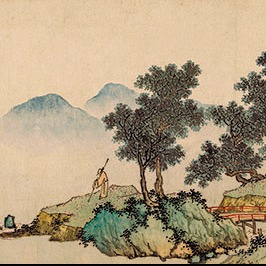Poetic brushwork relates a narrative


In 1531, Wen created a farewell painting for his friend Wang Chong, who's 24 years his junior. Showing the two of them lounging under pine trees, the painting was filled with a tranquil bliss that hid the sad story that was only referred to obliquely by Wen's inscription.
Calling himself "the white-haired", the 61-year-old Wen conceded that he was "no longer nurturing aspirations for a bureaucratic career". "All I'm seeing is a mighty bird who's about to soar and vanish from my aging sight," Wen told Wang, who's leaving for an exam held by the Ming Dynasty (1368-1644) government, the passing of which would allow him to continue his dream of becoming a court official.
Yet, the well-wishing Wen was proven wrong. Wang failed the exam for the eighth time. The disappointment was such that it broke the bird's wings — Wang died two years later in 1553, at 39.
The death devastated Wen, who had been through it all. Between 1498 and 1523, Wen took the exam nine times, having failed every previous one. He never made it.
"One cannot have a deep understanding of literati painting without recognizing one of its most popular and poignant themes — the failure by members of the group to pass the official exam and enter bureaucracy," says Pang.
"In the agrarian society of ancient China, that was almost the only way for personal advancement, and therefore an obsession for most educated men who saw the failures as major setbacks with lifelong repercussions."
Hope defeated, dream derailed — the feeling was commonly shared keeping in mind that only a very small number of people were allowed to pass the exam at any given time. Some of those who didn't, including Wen, dedicated themselves to painting and calligraphy instead, creating works that reflected both their literary background and individual experiences.
Su, who had turned increasingly to art after his political ambition was thwarted, must have spoken powerfully to these men. This is not to mention that his emphasis on literary cultivation as a foundation for artistic pursuits was in itself an affirmation to them, a reassurance of their wounded ego.
Yet, this is not to suggest insouciance or indifference on the part of Su or those who had taken up his art theories enthusiastically."I'm not avoiding the matters of the world, but rather, its maneuver and machination," wrote Su, who, while acting as a local administrator in the cities of Xuzhou and Hangzhou, was widely loved and respected for his relentless effort to fight flood and famine.

Of all the landscapes included in the exhibition, one stands out due to its theme, expounded on by the painter in his long inscription that takes up the work's upper side. Depicting half-inundated land lying desolately in the wake of persistent rain that had been going on for two months in northern Jiangsu between the spring and summer of 1705, the painter, Zhu Ruoji (1642-1707), lamented in the inscription on all the hardships endured by the masses, who were frequently subjected to either natural disasters or human warfare.
Zhu Ruoji, who for his entire artistic career went by the name Shitao (meaning "stone wave" or "petrified sea"), had come from the same Ming royal family that later produced Zhu Da (1626-1705), another towering art figure featured by the exhibition, for whom the fall of the Ming Dynasty in 1644 had induced tremendous pain.
"While a tendency did exist among literati painters to be more inward-looking and self-focused, some, as evidenced by this Zhu Ruoji painting, had indeed looked beyond their own small world," says Pang.
"And let anyone who's familiar with Su Shi's repertoire tell you, the man, despite his personal travails, was never one to wallow in self-pity. Instead, his writing was often described as bold, impassioned and free-spirited."
Su died at 64 on his way back to the Northern Song capital in modern-day Kaifeng city, Henan province, after being granted amnesty.
"According to the writing of one of his contemporaries, wherever he went, Su always carried in a pouch paper and brush, which allowed him to jot down any image that had caught his eye and tickled his heart — a scurrying crab for example," says Pang.
"In Su, profundity coexisted with sincerity and spontaneousness — that's why Su was so great and so relatable as a man and an artist."





































